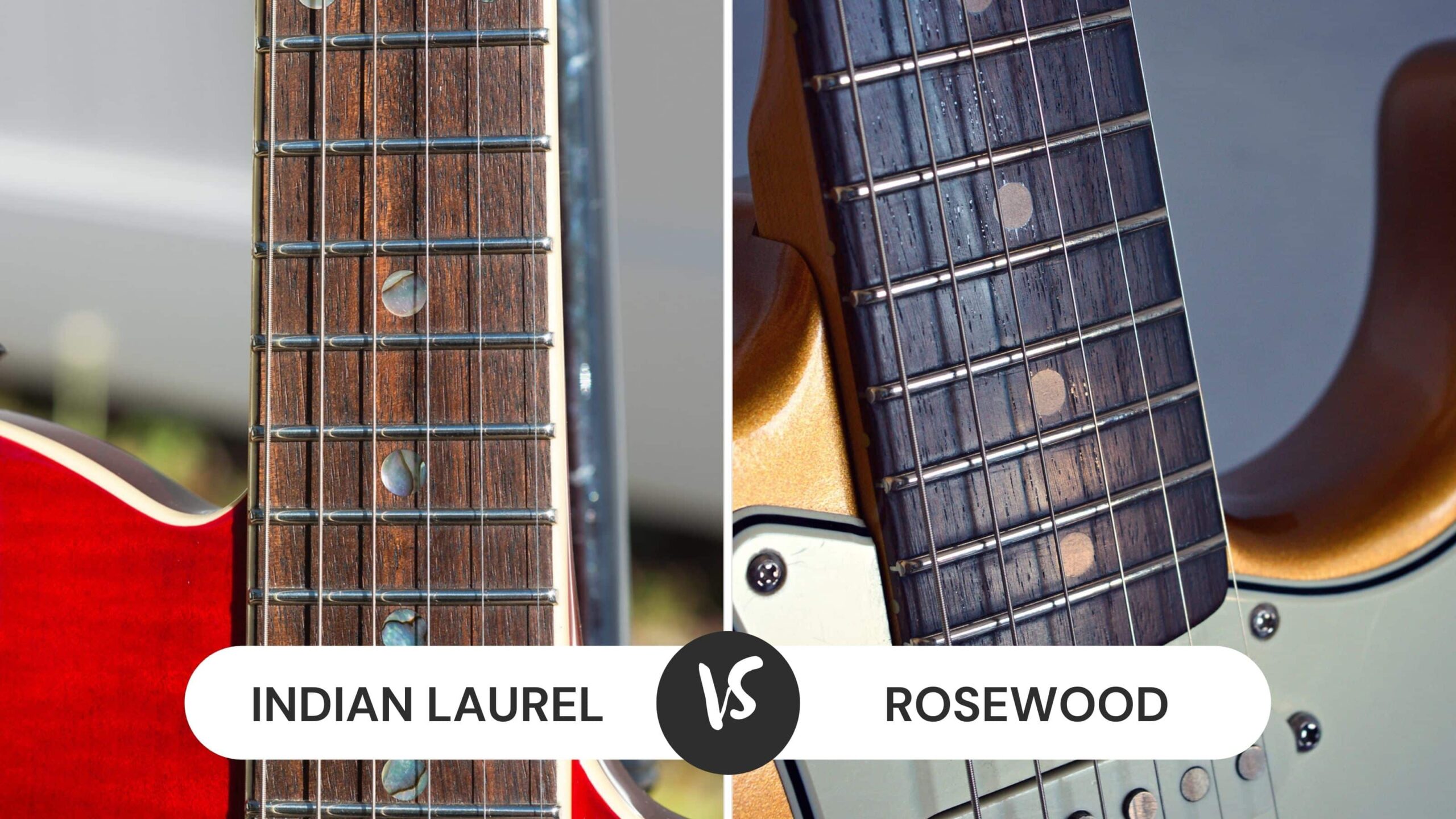Contents
All in all, today’s guitars incorporate a wide range of materials and different materials have different characteristics. Consequently, material comparisons show up from time to time in discussions among guitarists and Indian Laurel vs. Rosewood is one of them. Thanks to its dense and smooth properties, Indian Laurel is an excellent material for guitars. In the case of Rosewood, its tonal capabilities should guarantee well-balanced sound for most of the time.
New to guitars and could use some help once it comes to choosing between Indian Laurel and Rosewood? Then it’s suggested that you take a look at my article.
The Profiles Of The Materials

| Indian Laurel | Rosewood | |
| Scientific Name | Terminalia elliptica | Dalbergia |
| Appearance | Light or medium brown with dark streaks. | Ranges from reddish brown to deep purple-brown with grain patterns |
| Grain Pattern | Interlocking pattern | Straight or interlocking pattern depending on the species |
| Density (Kg/m3) | 690 – 900 | 600 – 1050 |
| Guitar Tonal Qualities | Smooth and responsive | Rich, warm and balanced |
| Janka Hardness (lbf) | 820 | 2,300-3000 |
Indian Laurel Vs. Rosewood: Insights

Tone
For your information, Indian Laurel is famous for generating a warm tone with a fantastic midrange. If you take advantage of the clear and focused sound of Indian Laurel, you will be able to pull off professional performances. Meanwhile, Rosewood is capable of delivering a complex tone with deep lows, sparkling highs and a scooped midrange. Because of that, not many materials manage to match Rosewood in terms of lushness.
Noteworthily, Indian Laurel produces a pleasing tone when it is new but the tone will not improve over time. On the other hand, the tone of Rosewood improves as it ages which is a big plus for long-term users.
Appearance
At a glance, Indian Laurel packs a dark brown shade with black streaks and interlocking patterns, all of which lead to a vintage feel. For Rosewood, its look varies depending on the species but most have a beautiful dark brown/reddish-brown shade with straight/interlocking patterns.
Durability
To put it plainly, Indian Laurel is lighter than Rosewood but it is in essence one of the leading materials regarding durability. The strength of Indian Laure makes it ideal for guitar fingerboards and instrument parts (ukuleles, bass guitars, etc). About Rosewood, it is harder and denser than Indian Laurel so it’s more resistant to wear and tear. Needless to say, guitars that make use of Rosewood should last for a long time.
Availability
Indian Laurel plantations exist all over Asia, especially in regions such as Nepal, Sri Lanka, Bangladesh and Bhutan. As a result, Indian Laurel is readily available and comes at reasonable prices in most of the cases. By contrast, Rosewood is rare and the harvesting of some Rosewood species is restricted as well. Thus, Rosewood costs more Indian Laurel and it’s not always available.
All things considered, Indian Laurel is the winner in Indian Laurel vs. Rosewood once it comes to availability.
Playability
As mentioned above, Indian Laurel features a smooth surface that is gentle on the hands and ensures a high level of comfort. Moreover, Indian Laure offers a firm grip on the strings and facilitates the process of striking chords. In the case of Rosewood, it’s also smooth and presents a comfortable feel. The integration of Rosewood in guitars usually enhances playing techniques like vibrato, string bending and so on.
A List Of Considerations

- The key consideration is the sound that you want your guitar to let out. Indian Laurel creates a well-balanced and warm tone while Rosewood puts together a complex and richer sound tone. Listen to the tone from both materials, give your taste some thought and decide accordingly.
- Those that favor fingerstyle while playing guitars should appreciate the characteristics of Indian Laurel tones. Meanwhile, Rosewood is usually a solid choice for lead players that like strumming,
- If you view the instrument as a long-term investment, think about how the tone may change throughout the years. If your guitar uses Rosewood, its tone is going to improve as time passes by but that is not the case with Indian Laurel.
Pau Ferro: The Ideal Alternative
In layman’s terms, since Indian Laurel and Rosewood have their ups and downs, it’s not uncommon for people to look for the “middle ground”. Quite a few materials match that title but Pau Ferro is usually the favorite. In terms of visuals, Pau Ferro is aesthetically pleasing owing to its dark brown hues and grain pattern. Additionally, Pau Ferro can deliver a resonant tone that improves the overall guitar’s sound regardless of the playing style.

Hi music fan! I am Jeff. Hope that you enjoy some stuff I shared here in my personal blog.
About myself, Currently I am in charging as Artist Manager/Music Supervisor at 72 Music Management. I did managed album to Grammy Award in 2017 with 7 Nominations from 2014-2020 and had the opportunities to work with : A.J. Croce, Blind Boys of Alabama, Bobby Rush, Dom Flemons, Dustbowl Revival, Sarah Grace
Governor of the Memphis Chapter of The Recording Academy is one of a award that I am lucky to achieved.
